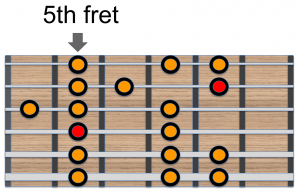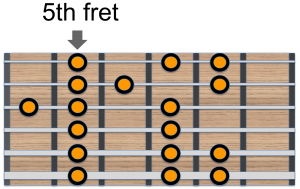Scalar interchange refers to the technique of changing the scale over different key centres or even over specific chords. This technique is used rarely in rock and pop where the key tends to remain the same. In Blues and Jazz however, this technique is highly useful. In this article, we will examine how we can apply scalar interchange over a simple jazz progression.
The Circle of 5ths Progression
This chord progression contains both major II-V-I and the minor II-V-I progressions within its 8 bars. Bar 4 contains the IVmaj7 chord of the key to connect to the minor II-V-I in bar 5. The progression ends by changing the iv minor7 into a dominant 7 to resolve back to the Dm7 so that the progression can repeat itself.
Here we will apply it in the key of C major.

Clearly, the first 5 bars are diatonic to the key of C major. Let us examine the minor II-V-I in bars 5 to 7.
The minor II-V-I is derived by firstly rearranging the chords to begin with the relative minor. In other words, the Amin7 chord is now the I chord. Therefore the II chord in a minor II-V-I will be the subsequent chord i.e. the Bmin7(b5). The V chord resolving to the I is always a dominant 7th chord. However, in a minor II-V-I progression, this V7 chord is altered. So instead of an E7, we have here an E7(b9) chord to resolve to the Amin7. The E7(b9) chord will not fit the C major key and can be seen as a borrowed chord.
Lastly, the chord in bar 8 is an A7 which does not belong to the key of C major. There are 2 ways to see the A7. It can either be seen as a secondary dominant chord resolving to the II (i.e. V7/II) or we can see it as a borrowed V7 chord from the key of D major.
Changing in Position
In summary, since bars 1 to 5 and bar 6 are diatonic to C major, we can use the C major scale over these bars. In the 5th position, the scale box for C major is shown below in diagram 1. You might recognise this as the A minor scale box which belongs in the key of C major.
Treating the E7(b9)
The simplest way to learn how to address the E7(b9) chord is to raise the G note in the C major scale by a half step to a G#. If we spell out this new scale we get
E, F, G#, A, B, C, D
and if we rearrange to start from A we get
A, B, C, D E, F, G#
This is essentially the A harmonic minor scale. It differs from the A minor scale by only one note. In other words, use the A minor scale for bars 1 to 5 but in bar 6, temporarily raise the G note up one fret to G#. In bar 7 return this note to G.
The scale diagram on the near right shows the A minor scale box. The red note is the G note in this scale box.
Simply shift this single note up one fret to G# to get the A harmonic minor scale. This is done only over the E7(b9) chord.

C major scale box at 5th fret
(also A minor scale)

A Harmonic Minor scale
Treating the A7 chord in bar 8
Finally, we come to the A7 chord in bar 8. Note that A7 does not exist in the key of C major. In fact, it is the V7 chord of the key of D major. We can look at this 2 ways.
Firstly, we can see that the progression transposes up a whole step to they of D temporarily over bar 8. We can use changing position and shift the scale accordingly up 2 frets. Alternatively, we can use the A Mixolydian scale over the A7 chord. The A Mixolydian scale is essentially the D major scale starting on A.
Instead of playing the D major scale at another fret, by using the A Mixolydian scale box at the 5th fret, we are essentially changing the scale in position, from C major scale to D major scale. Hence the name ‘Scalar Interchange’.
In Summary.
The 3 scale diagrams below are used over this chord progression with the first scale box being used over bulk of the chords. If we were to analyze the notes of A Mixolydian over bar 8, we would get the notes
A mixolydian scale: A, B, C#, D E, F, G.
which differs from the A minor scale by a single note i.e. C#.
A minor scale: A, B, C, D E, F, G.
Therefore, this whole exercise can be simply interpreted as changing a single note i.e. the G to G# over the E7(b9) and the C to C# over the A7. Instead of finding that note on the fretboard in isolation, it would be easier to learn where those notes lie with respect to the A minor scale. By changing this note, your entire scale box changes and you will be better equipped for chord tone targeting.

A Minor Scale
(to be used over bars 1 to 5 and bar 7)

A Harmonic Minor
(to be used over bar 6)

A Mixolydian Scale
(to be used over bar 8)
The video below demonstrates the above concepts.
The next video in the series is Chord Tone Soloing for Blues using Scalar Interchange
Like us on Facebook or follow us on Instagram for the latest in content in chord tone soloing.
